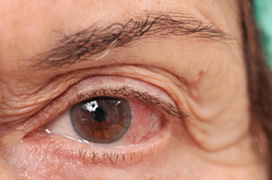Allergic conjunctivitis is the inflammation and swelling of the tissue lining the eyelids and the white of the eye, the conjunctiva, in reaction to allergy-causing conditions such as:
- Pollen
- Dander
- Dust
- Mold

Causes of Allergic Conjunctivitis
The allergy may be seasonal, often occurring alongside hay fever, or it may occur throughout the year, known as perennial, as a result of exposure to allergens such as dust mites, mold or animal dander. Both are very common conditions, especially for patients with family histories of asthma, eczema or rhinitis. Less frequently, people can develop allergic eye disease from wearing hard or soft contact lenses, as a complication of atopic eczema, or for other reasons. Patients with this condition may also suffer from dry eyes and blepharitis.
When exposed to an allergen, histamines are released which results in the swelling of blood vessels in the conjunctiva. Other causes of allergic conjunctivitis include:
- Grass
- Ragweed
- Trees
- A family history of allergies
Symptoms of Allergic Conjunctivitis
Some of the symptoms will depend on the allergy season and the type of allergy. Some of the symptoms of allergic conjunctivitis may include:
- Red, itchy eyes
- Puffy eyes
- Discharge
- Tearing
- Burning eyes
Treatment of Allergic Conjunctivitis
Allergic Conjunctivitis is uncomfortable but it rarely causes injury. Treatment varies depending on the cause, history and symptoms, and may include topical or oral antihistamines, topical corticosteroids or eye drops. Cold compresses may also relieve discomfort. Reducing exposure to allergens, if at all possible, is also an option.
